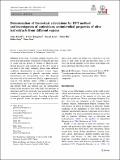DSpace Repository
The outcomes of transobturator tape intervention in the treatment of stress urinary incontinence: Two years' follow-up
- DSpace Home
- →
- Web Of Science
- →
- Web Of Science
- →
- View Item
JavaScript is disabled for your browser. Some features of this site may not work without it.
| dc.contributor.author | Bulat, Aytek
|
|
| dc.date.accessioned | 2024-04-29T10:02:13Z | |
| dc.date.available | 2024-04-29T10:02:13Z | |
| dc.date.issued | 2019 | |
| dc.identifier.issn | 1682-024X | |
| dc.identifier.uri | http://hdl.handle.net/11547/11638 | |
| dc.description.abstract | Objective: To evaluate the clinical outcomes and the effects on quality of life of transobturator tape surgery during a 2-year follow-up period in our clinics. Methods: Eighty-seven patients with stress or mixed urinary incontinence who underwent transobturator tape surgery were included in the study conducted in Istanbul. Taksim. Training. and Research Hospital Gynecology and Obstetrics Clinic, between 2011 and 2013. The patients' demographic features, incontinence questionnaires, quality of life scores [Incontinence Impact Questionnaire (IIQ-7) and urinary distress inventories (UDI-6)], examination findings, urodynamic results, stress tests, Q tip tests, number of daily pads, ultrasonography, surgery, and cystoscopy results were recorded. Patients were evaluated 23-27 months (mean: 25.40 +/- 1.31 months) after their discharge in terms of symptoms, quality of life scores, urodynamic findings, complications, and stress test. Results: Sixty-three (72.4%) patients had stress incontinence and 24 (27.6%) patients had mixed urinary incontinence. No perioperative complications were observed in our study. After a follow-up period of two years, a significant improvement was detected in the IIQ-7 and UDI-6 questionnaires when compared with the preoperative period. Moreover, the objective cure rate was found as 88.5% (n=77). De novo urge incontinence was obtained in 5.7% (n=5) of patients and was treated with anticholinergics. Perineal pain was present in 3 (3.44%) patients and was treated with analgesics and cold packs. In 2 (2.29%) patients, vaginal mesh erosion was detected and full recovery was achieved with an excision. Urinary retention and bladder perforation was not seen in any patients. Conclusion: Our study revealed a high objective cure rate, and an improvement in symptoms and quality of life with the transobturator tape operation | tr_TR |
| dc.language.iso | en | tr_TR |
| dc.title | The outcomes of transobturator tape intervention in the treatment of stress urinary incontinence: Two years' follow-up | tr_TR |
| dc.type | Article | tr_TR |
Files in this item
This item appears in the following Collection(s)
-
Web Of Science [1152]
